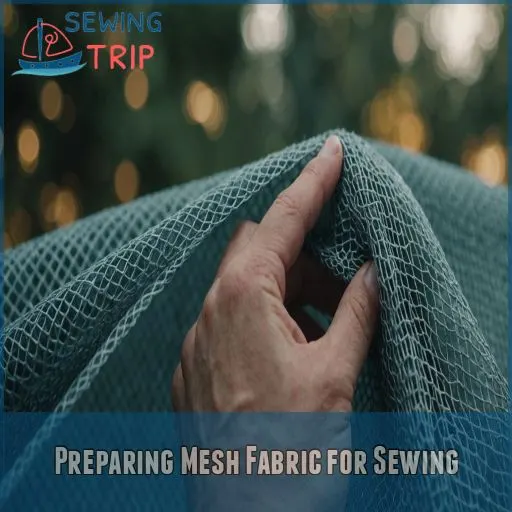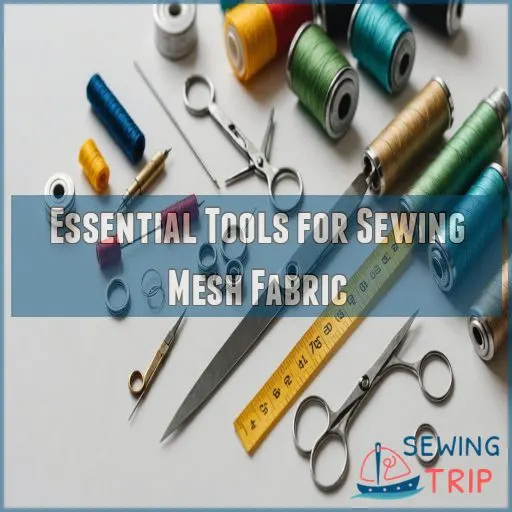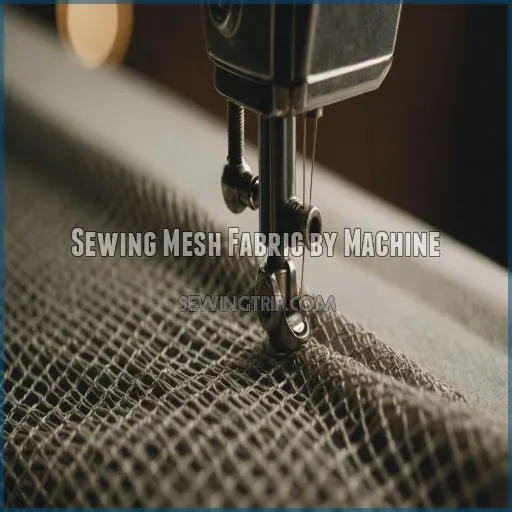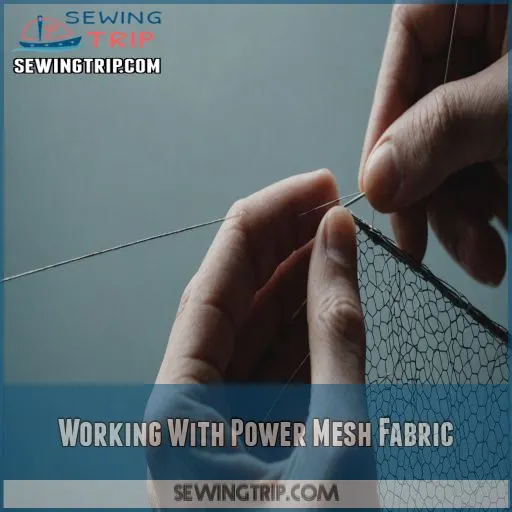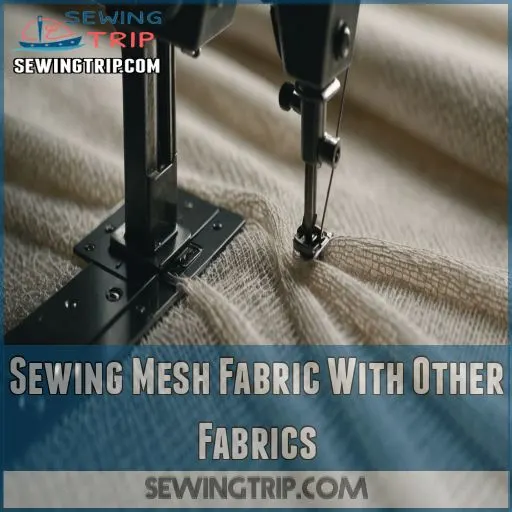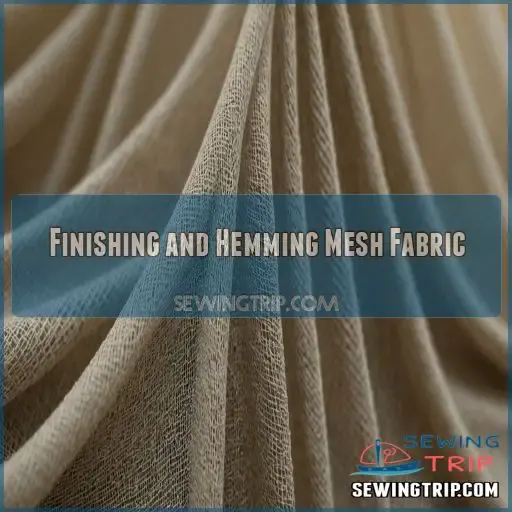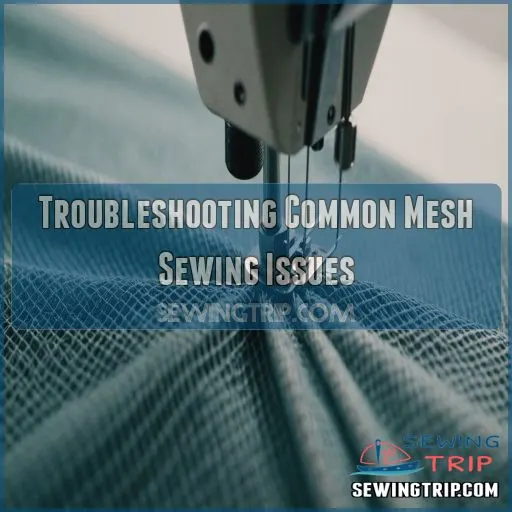This site is supported by our readers. We may earn a commission, at no cost to you, if you purchase through links.
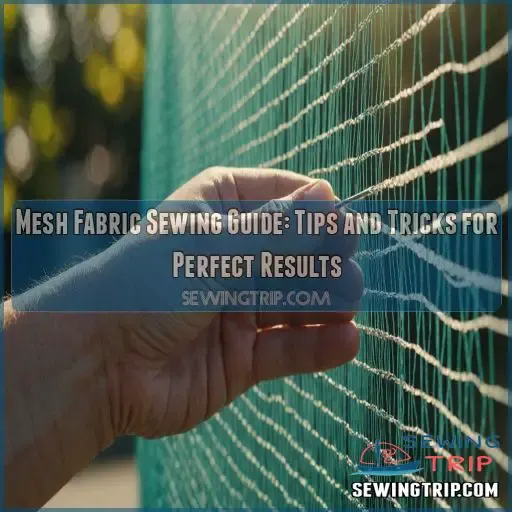
Here’s the scoop: mesh fabric can be slippery, but with the right needle—a ballpoint or stretchy type—you’re off to a great start. It’s like having the secret weapon in your sewing toolkit.
Prep your fabric by washing and drying it properly, then grab sharp tools for clean cuts. Secure it with extra-fine pins and use a walking foot for ease.
Table Of Contents
- Key Takeaways
- Choosing the Right Needle for Mesh
- Preparing Mesh Fabric for Sewing
- Essential Tools for Sewing Mesh Fabric
- Sewing Mesh Fabric by Machine
- Working With Power Mesh Fabric
- Cutting Mesh Fabric With Ease
- Sewing Mesh Fabric With Other Fabrics
- Finishing and Hemming Mesh Fabric
- Troubleshooting Common Mesh Sewing Issues
- Creative Projects With Mesh Fabric
- Frequently Asked Questions (FAQs)
- Conclusion
Key Takeaways
- Choose the right needle: Don’t let mesh fabric be the boss of you. Use a ballpoint or stretch needle to glide through it smoothly, like a hot knife through butter. These needles prevent snagging and skipped stitches, making sure your project stays on track.
- Prepare and cut like a pro: Treat your mesh fabric as you would a diva—handle with care. Wash it gently, and when cutting, use sharp scissors or a rotary cutter for precise, clean edges. It’s like slicing through a perfectly ripe avocado.
- Use the right tools: Think of a rotary cutter and self-healing mat as your trusty sidekicks. They make cutting mesh a breeze, like having Batman and Robin on speed dial. And don’t skimp on quilter’s clips or extra-fine pins to keep everything neatly in place.
- Sew with care and technique: Imagine you’re guiding a shy butterfly—slow and steady wins the race. Use a walking foot to prevent puckering and stretching, and opt for strong polyester thread. Sew with patience, and you’ll be whipping up mesh garments like a pro in no time.
Choosing the Right Needle for Mesh
When sewing with mesh fabric, choosing the right needle can save you from a tangled mess of stitches and frustration.
You’ll want to grab a ballpoint or stretchy needle to glide smoothly through your fabric, making your sewing experience a breeze.
Ballpoint or Stretchy Needles for Mesh
Choosing the right needle for mesh fabric can feel like threading a needle in the dark.
You’ve got two trusty companions: ballpoint or stretchy needles.
These handy tools, with their rounded tips, dance through the weave without a hitch.
They prevent the fabric from snagging or skipping stitches, ensuring your sewing machine sails smoothly through every project.
Universal Needle Size Options for Mesh
You have options when it comes to needle size for sewing mesh fabric. A universal needle size of 70/10 or 80/12 can work if specialized needles aren’t available.
Here are 4 key considerations:
- Needle type – Ballpoint or stretchy needles glide smoothly through the open weave.
- Fabric weight – Heavier mesh may require a larger needle.
- Stitch length – Shorter stitches (1.75-2.5 mm) provide more stretch resistance.
- Sewing machine compatibility – Check your machine’s recommendations for the best results.
Needle Sizes for Specific Mesh Fabric Types
It’s time to thread the needle and get specific! Mesh fabric isn’t one-size-fits-all.
Embroidered mesh demands a delicate touch with a size 70/10 needle.
Power mesh for active wear or bra making? Try a robust 80/12.
Keep stitch length short for control.
A smaller needle hugs lightweight fabric; a larger one dances with heavyweight projects.
Preparing Mesh Fabric for Sewing
Before you start sewing mesh fabric, take some time to properly prepare it by washing and ironing it; you’ve got to treat it right, just like a favorite T-shirt!
Mark your fabric using chalk or erasable pens, and cut it carefully with sharp scissors or a rotary cutter—precision is key, and safety scissors just won’t cut it (sadly, pun intended).
Washing and Ironing Mesh Fabric
Washing mesh fabric in cold water keeps it happy and stretchy.
Go easy on the spin cycle since it’s like a roller coaster for fragile threads.
When ironing, low heat is your friend, but no direct metal-to-mesh contact, please! Steam it gently, like you’re wooing a delicate souffle.
Dry flat, steering clear of Dracula-like shrinking.
- Cold wash for gentle care
- Gentle spin to avoid damage
- Low iron setting to prevent burns
- Steam setting to spruce up
- Flat drying to maintain shape
Using Chalk or Erasable Pens for Marking
Marking mesh fabric can be a breeze with the right tools.
Reach for chalk or erasable pens – they glide smoothly over the open weave without snagging.
Take your time, holding the fabric taut, and mark small sections at a time for precise lines.
These handy markers make it easy to map out your sewing plan.
Cutting Mesh Fabric With Sharp Scissors and Rotary Cutters
While marking your mesh art project, remember that cutting requires precision and patience.
Glide through mesh layers like a pro using sharp scissors or a trusty rotary cutter – it’s like slicing through butter!
When handling delicate see-through sportswear fabric types, prioritize safety tips: protect fingers, avoid fraying, and visualize dazzling project ideas. You’ve got this!
Essential Tools for Sewing Mesh Fabric
When sewing mesh fabric, having the right tools makes all the difference—kind of like trying to whisk eggs with a garden rake!
You’ll need a rotary cutter, self-healing mat, and the delicate touch of quilter’s clips or extra-fine pins to keep your project smooth and snag-free.
Rotary Cutters and Self-Healing Mats for Cutting
When cutting mesh fabric, consider the rotary cutter your best buddy. It slices through with ease, like cutting butter on a hot day.
Pair it with a self-healing mat for smooth sailing and fabric freedom.
Now, go cut some creativity!
Quilter’s Clips, Ballpoint Pins, or Extra-Fine Pins for Pining
Why not try quilter’s clips, ballpoint pins, or extra-fine pins to keep your slippery mesh fabric securely in place?
These specialized pinning tools will prevent shifting and distortion, ensuring your seams stay straight and your project turns out flawlessly.
Just be sure to choose the right pin size for your mesh type – a little preparation goes a long way!
Walking Foot and Stabilizers for Smooth Sewing
Steering mesh with quilter’s clips securely pinned, prevail over fabric slipping by wielding a trusty walking foot, a great option for sewing wool as mentioned in the best sewing machine foot for wool! This nifty tool helps create seamless stitch quality and foils tension issues like a pro.
Pair it with the right stabilizer and you’re golden:
- Tear-away stabilizer: Prevents puckering.
- Tissue paper: Keeps mesh taut.
- Plain paper: For tension balance.
- Fabric-safe choice: Avoids mishaps.
Sewing Mesh Fabric by Machine
Sewing mesh fabric by machine can feel like a tricky dance, but with the right moves, you’ll waltz right through.
It’s all about using a strong thread, setting the stitch length just right, and taking things slow and steady to avoid any awkward puckering.
Using Strong Thread for Mesh Fabric
So, you’re ready to sew mesh fabric but don’t skimp on thread! Always opt for strong, durable polyester thread—it’s your best buddy.
And by the way, here’s a handy table to guide you:
| Thread Type | Thread Weight | Use With |
|---|---|---|
| Polyester | 40 wt | Activewear |
| Nylon | 30 wt | Power Mesh Lingerie |
| Cotton | 50 wt | Light Mesh Decor |
Tweaking thread tension and colors amps up your sewing game!
Setting the Stitch Length for Secure Stitches
When sewing mesh fabric, choose a shorter straight stitch length, around 1.75-2.5 mm.
This tight stitch pattern will provide the necessary stretch resistance and seam strength to prevent the delicate mesh from tearing or distorting.
Adjust the stitch length based on the thickness of your mesh – lighter fabrics may require an even shorter stitch.
Sewing Slowly and Steadily to Prevent Puckering
To keep your mesh fabric tension under control, imagine you’re gently holding a delicate butterfly while sewing.
Slow down your machine and keep a steady hand.
Adjust your machine settings for slow stitching tips to counter puckering.
Like dancing gracefully, guide the fabric without pulling too hard, and watch for signs of puckering.
Patience is your best buddy here!
Working With Power Mesh Fabric
When you’re working with power mesh fabric, you’ll find it’s a super versatile material, perfect for everything from compression garments to bra bands.
Choosing the right weight makes all the difference in comfort and performance, just like how you love a trusty pair of sneakers.
Characteristics of Power Mesh Fabric
While stitching mesh fabric with machine precision, you’ll run into power mesh—it’s like mesh’s strong, sassy cousin. Power mesh offers:
- Weight mix: Various weights for different needs.
- Durability boost: Built tough for many uses.
- Compression level: Shapes and supports.
- Breathability factor: Keeps things cool.
- Transparency touch: Adds peek-a-boo allure.
Common Uses of Power Mesh Fabric
Power mesh fabric is a versatile material perfect for everything from bra band wings to medical apparel.
Power mesh delivers the stretch, support, and breathability your body craves.
Its compression properties make it a go-to choice for activewear, dancewear, and swimwear lining.
Whether you’re sewing a sports bra or a pair of leggings, power mesh is a great choice.
Choosing the Right Weight of Power Mesh Fabric
Finding the perfect power mesh weight for your project is like choosing the right teammate. Each one has its game. Whether it’s a high-compression sports bra or a light dance outfit, consider:
- Compression level: Heavyweight for strong support.
- Garment type: Light for delicate lingerie.
- Fabric weight: Match to your project goals.
- Body type: Choose for personal comfort.
Cutting Mesh Fabric With Ease
Cutting mesh fabric can be tricky, but a few clever tricks will make it manageable.
Picture yourself as a kitchen ninja using a rotary cutter and self-healing mat to slice through one layer at a time—no fraying, just clean, precise cuts!
Tips for Cutting Mesh Fabric Without Fraying
To cut mesh fabric without fraying, imagine you’re slicing through butter with sharp scissors or fabric shears, just like you would when using a designated pair of scissors for fabric. Keep your cutting board sturdy and slice one layer at a time. Precision is key!
| Tool | Advantage | Pro Tip |
|---|---|---|
| Sharp Scissors | Clean edges | Snip slowly |
| Fabric Shears | Control | Hold fabric taut |
| Rotary Cutters | Consistency | Focus on one layer |
Avoid hacking it to bits like spaghetti!
Using a Rotary Cutter and Self-Healing Mat for Cutting
Grab your trusty rotary cutter and self-healing mat – they’re your new best friends for cutting mesh fabric.
Run the blade smoothly across the surface, keeping the mat underneath to prevent fraying.
Remember to replace dull blades and maintain your mat to make sure you get clean, precise cuts every time.
It’s all about that perfect fabric alignment!
Cutting Mesh Fabric One Layer at a Time
For neat, fray-free edges, slice mesh fabric one layer at a time.
Like a chef with a fine blade, a rotary cutter offers precision and grace.
Think about it this way:
| Do’s | Don’ts |
|---|---|
| Use sharp scissors | Stack layers |
| Cut on a mat | Rush the process |
| Mark your fabric | Skip marking |
| Align your edges | Ignore alignment |
Cutting leads to frustration-free sewing!
Sewing Mesh Fabric With Other Fabrics
When you’re sewing mesh fabric with other materials, it’s like trying to juggle jello – it can be tricky, but also rewarding with the right techniques.
Use a walking foot to steer the fabric smoothly and prevent anything from turning into a crumpled mess.
Positioning the Mesh Layer for Smooth Sewing
Imagine you’re the conductor of your sewing symphony.
Placing the mesh layer as the top layer lets it take center stage, giving you control over fabric tension and preventing slipping.
It’s like letting the prima ballerina lead.
You’ll keep the fabric drama to a minimum!
This technique adds finesse to your stitching, ensuring smooth seams every time.
Using a Walking Foot for Guiding the Fabric
When sewing mesh fabric with other materials, a walking foot is your secret weapon.
This clever attachment grips both layers evenly, guiding the fabric through your machine smoothly.
Say goodbye to uneven feeding and puckered seams – the walking foot makes sure your mesh plays nicely with its woven companions for professional-looking results.
Preventing Snagging and Puckering
Sewing mesh fabric alongside other fabrics can feel like walking on a tightrope.
Keep tension in check and prevent snagging by using a sharp needle and placing a stabilizer underneath.
Select a shorter stitch length and reduce sewing speed.
Remember to let the feed dogs do their job—don’t pull the fabric!
Stay calm and sew on!
Finishing and Hemming Mesh Fabric
When you’re finishing and hemming mesh fabric, it’s important to choose methods that enhance its airy, stretchy qualities.
Try using French seams for a neat look, or opt for a rolled hem if you’re feeling fancy—your mesh will look fabulous without needing to jump through hoops!
French Seams for a Neat Finish
Pairing mesh with other fabrics? Keep it neat with French seams. They’re not just for French fries!
Start by sewing a narrow seam with the mesh’s wrong sides together. Trim, press, flip, then sew again with right sides.
Voilà—a tidy, enclosed edge, no raw bits showing! Perfect for power mesh applications and showcasing your seam-finishing artistry!
Rolled Hem and Gathered Edge Options
Don’t fret over hemming mesh – it’s a breeze! Explore the charm of a rolled hem, where you can stitch three lines for a polished look.
Or, embrace the gathered edge, adorning your mesh with bias binding, trim, ribbon, or fold-over elastic for a touch of whimsy.
The choice is yours – let your creativity shine!
- Rolled Hem: Three lines of stitching for a refined finish
- Gathered Edge: Decorate with bias binding, trim, ribbon, or fold-over elastic
- Hemming Optional: Mesh’s stretchy nature means you don’t always need to hem
Troubleshooting Common Mesh Sewing Issues
Don’t let sewing mesh fabric turn into a tangled mess—you’re in control.
We’ll tackle common issues like stretching, puckering, and thread breakage with ease, ensuring your projects stay on track.
Preventing Stretched or Distorted Mesh Fabric
To keep mesh fabric from stretching or distorting, consider stitch selection and stabilizer types. Pin techniques are also important. Think of mesh tension like a balancing act.
| Tip | Description |
|---|---|
| Use Tissue Paper | Adds stability under seams |
| Pins or Quilt Clips | Holds layers in place, preventing shifting |
| Adjust Machine Tension | Keeps thread in sync and mesh snug |
| Shorten Stitch Length | Provides firm support |
| Sew Slowly | Maintains control over potentially slippery mesh |
Fixing Puckered or Snagged Mesh Fabric
Ever tried sewing mesh, only to face the horror of puckering and snagging?
First things first, check your machine’s tension—it might be tighter than a drum in a parade!
Using a stabilizer can work wonders, and if a seam goes wrong, don’t hesitate to wield that seam ripper with grace.
Mesh fabric repair just got a tad easier!
Solving Thread Breakage Issues
Experiencing thread breakage can be frustrating, but don’t worry – we’ve got your back!
To solve this issue, try these four tips:
- Adjust the thread tension on your machine.
- Switch to a new, high-quality needle.
- Make sure your mesh fabric is of good quality and not overly delicate.
- Slow down your sewing speed and watch for knots or tangles.
With a little troubleshooting, you’ll be sewing mesh like a pro in no time!
Creative Projects With Mesh Fabric
If you’ve got an itch for sewing and a pile of mesh fabric, let’s turn that into sporty wear or gorgeous lingerie that makes you say, "I made this!"
With the right techniques, your creations will be as exceptional and airy as grandma’s secret pancake recipe.
Making Activewear and Sportswear With Mesh
You’ve conquered mesh sewing issues, so let’s shift gears.
Imagine crafting activewear with athletic mesh—it’s a slam dunk for comfort and flexibility!
The airy fabric keeps you cool, like a personal breeze during workouts.
Explore sportswear design trends, blending different mesh fabric types for unique flair.
Mesh’s strength and breathability make your creations feel like second skin!
Creating Lingerie and Swimwear With Power Mesh
Creating lingerie and swimwear with power mesh is like sculpting comfort tailor-made to your body.
Thanks to power mesh’s elasticity, your projects can embrace every curve with grace—perfect for lingerie construction or swimwear linings.
High on breathability and mesh comfort, these designs won’t just hold up well; they’ll make your spirits soar.
Also, consider bra band designs for superior fit!
Using Mesh Fabric for Home Decor and Accessories
Mesh fabric’s airy, see-through nature makes it a versatile choice for home decor and accessories.
Craft breezy mesh curtains to let natural light flow through.
DIY mesh lampshades for a modern touch.
Weave mesh baskets for stylish storage.
Sew decorative mesh pillows to add texture to your space.
The possibilities are endless when you explore your creativity with this adaptable fabric.
Frequently Asked Questions (FAQs)
How to sew mesh fabric for beginners?
Sewing mesh fabric is like walking a tightrope – with the right tools and techniques, you’ll glide through it effortlessly.
Grab your ballpoint needle, steady your pace, and let the fabric flow through your machine like a graceful dance.
What needle to use for mesh fabric?
When you’re working with mesh fabric, grab a ballpoint or stretchy needle, like a 70/10 or 80/
They have rounded tips that slide effortlessly through fibers, preventing pesky pulls and skipped stitches.
Happy sewing!
What to make with mesh fabric?
Imagine crafting a breezy sports jersey with mesh fabric.
You’d stay cool during workouts and still look trendy.
This material’s your best buddy for projects where breathability and style go hand in hand—give it a whirl!
How do you stick mesh fabric together?
Sticking mesh fabric can feel like taming a wild horse, but using fabric glue or a fusible interfacing makes the task a breeze.
Apply sparingly, ensuring even coverage, and let it dry completely—patience pays off!
How to maintain mesh fabric durability long-term?
To maintain mesh fabric’s durability long-term, you’ll want to handle it with care.
Avoid over-stretching, and wash it gently in cool water.
Air-drying is best to prevent shrinkage.
With a little TLC, your mesh will stay strong and vibrant for seasons to come.
What stabilizer options are best for mesh fabric?
Use tear-away stabilizers, tissue paper, or plain paper under the seam to prevent mesh fabric from getting trapped.
They act like a secret bodyguard, keeping your fabric safe while you work your sewing magic.
Can mesh fabric be hand-sewn effectively?
Absolutely, you can hand-sew mesh fabric like a sewing ninja!
Just use a sharp needle, sturdy thread, and patience.
Little snags and tangles might crop up, but with practice, you’ll breeze through without breaking a sweat.
What are unique design uses for mesh fabric?
Mesh fabric design possibilities are endless! You can transform it into sporty jerseys, ethereal drapes for windows, or even sassy overlays for dresses.
Imagine your garden, with mesh trellises giving your climbing plants a breathable hug.
How to repair damaged mesh fabric sections?
Don’t sweat it – repairing damaged mesh is a breeze!
Simply patch it up with a bit of fusible web or clear nail polish,
and you’ll have that fabric looking good as new in no time.
Easy peasy!
Conclusion
Think of your sewing machine as a dance partner and mesh fabric as a delicate waltz to master.
With this "mesh fabric sewing guide," you’ve got the moves to glide gracefully across any project.
Whether you’re stitching up sporty activewear or crafting dainty decor, your newfound skills will help you achieve professional results.
So, grab your tools, let your creativity flow, and remember—when mesh mishaps arise, a bit of patience and these tips will smooth the way.
Happy sewing!


